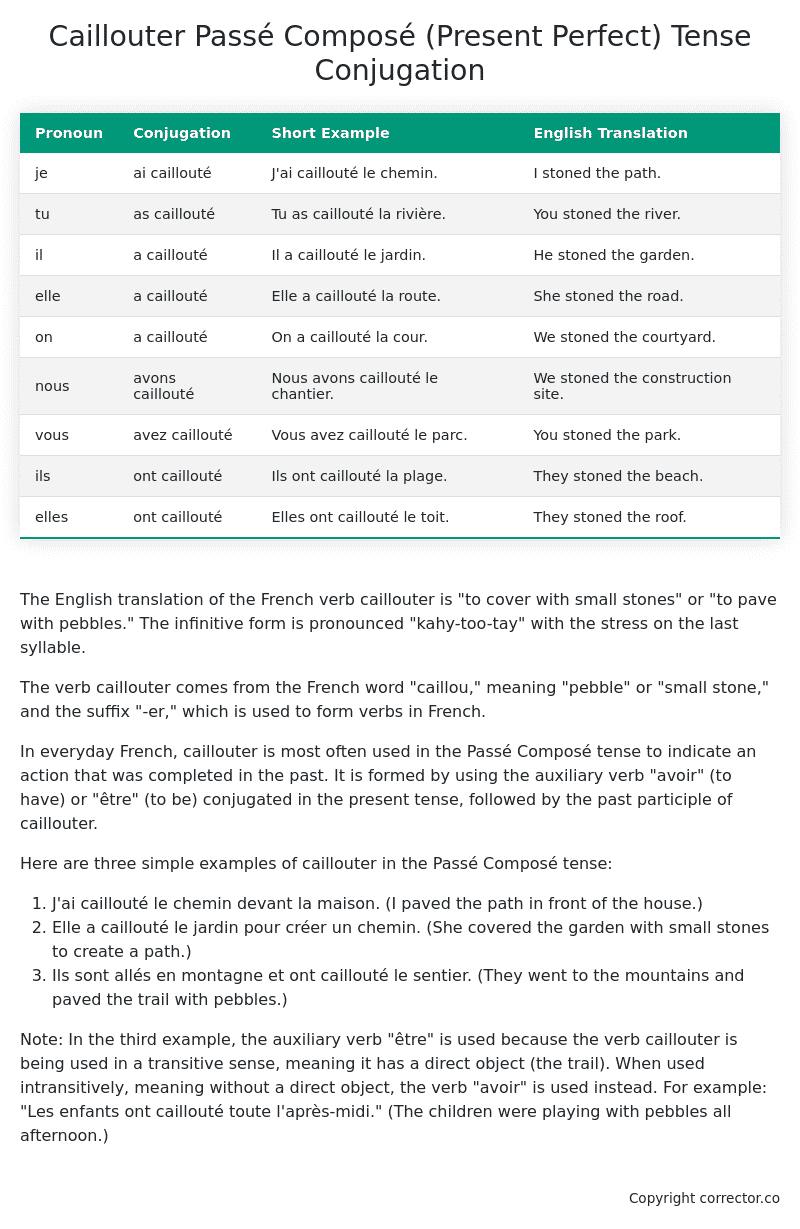Passé Composé (Present Perfect) Tense Conjugation of the French Verb caillouter
Introduction to the verb caillouter
The English translation of the French verb caillouter is “to cover with small stones” or “to pave with pebbles.” The infinitive form is pronounced “kahy-too-tay” with the stress on the last syllable.
The verb caillouter comes from the French word “caillou,” meaning “pebble” or “small stone,” and the suffix “-er,” which is used to form verbs in French.
In everyday French, caillouter is most often used in the Passé Composé tense to indicate an action that was completed in the past. It is formed by using the auxiliary verb “avoir” (to have) or “être” (to be) conjugated in the present tense, followed by the past participle of caillouter.
Here are three simple examples of caillouter in the Passé Composé tense:
- J’ai caillouté le chemin devant la maison. (I paved the path in front of the house.)
- Elle a caillouté le jardin pour créer un chemin. (She covered the garden with small stones to create a path.)
- Ils sont allés en montagne et ont caillouté le sentier. (They went to the mountains and paved the trail with pebbles.)
Note: In the third example, the auxiliary verb “être” is used because the verb caillouter is being used in a transitive sense, meaning it has a direct object (the trail). When used intransitively, meaning without a direct object, the verb “avoir” is used instead. For example: “Les enfants ont caillouté toute l’après-midi.” (The children were playing with pebbles all afternoon.)
Table of the Passé Composé (Present Perfect) Tense Conjugation of caillouter
| Pronoun | Conjugation | Short Example | English Translation |
|---|---|---|---|
| je | ai caillouté | J’ai caillouté le chemin. | I stoned the path. |
| tu | as caillouté | Tu as caillouté la rivière. | You stoned the river. |
| il | a caillouté | Il a caillouté le jardin. | He stoned the garden. |
| elle | a caillouté | Elle a caillouté la route. | She stoned the road. |
| on | a caillouté | On a caillouté la cour. | We stoned the courtyard. |
| nous | avons caillouté | Nous avons caillouté le chantier. | We stoned the construction site. |
| vous | avez caillouté | Vous avez caillouté le parc. | You stoned the park. |
| ils | ont caillouté | Ils ont caillouté la plage. | They stoned the beach. |
| elles | ont caillouté | Elles ont caillouté le toit. | They stoned the roof. |
Other Conjugations for Caillouter.
Le Present (Present Tense) Conjugation of the French Verb caillouter
Imparfait (Imperfect) Tense Conjugation of the French Verb caillouter
Passé Simple (Simple Past) Tense Conjugation of the French Verb caillouter
Passé Composé (Present Perfect) Tense Conjugation of the French Verb caillouter (this article)
Futur Simple (Simple Future) Tense Conjugation of the French Verb caillouter
Futur Proche (Near Future) Tense Conjugation of the French Verb caillouter
Plus-que-parfait (Pluperfect) Tense Conjugation of the French Verb caillouter
Passé Antérieur (Past Anterior) Tense Conjugation of the French Verb caillouter
Futur Antérieur (Future Anterior) Tense Conjugation of the French Verb caillouter
Subjonctif Présent (Subjunctive Present) Tense Conjugation of the French Verb caillouter
Subjonctif Passé (Subjunctive Past) Tense Conjugation of the French Verb caillouter
Subjonctif Imparfait (Subjunctive Imperfect) Tense Conjugation of the French Verb caillouter
Subjonctif Plus-que-parfait (Subjunctive Pluperfect) Tense Conjugation of the French Verb caillouter
Conditionnel Présent (Conditional Present) Tense Conjugation of the French Verb caillouter
Conditionnel Passé (Conditional Past) Tense Conjugation of the French Verb caillouter
L’impératif Présent (Imperative Present) Tense Conjugation of the French Verb caillouter
L’infinitif Présent (Infinitive Present) Tense Conjugation of the French Verb caillouter
Struggling with French verbs or the language in general? Why not use our free French Grammar Checker – no registration required!
Get a FREE Download Study Sheet of this Conjugation 🔥
Simply right click the image below, click “save image” and get your free reference for the caillouter present perfect tense conjugation!

Caillouter – About the French Passé Composé (Present Perfect) Tense
Formation of the Passé Composé
Set the auxiliary verb with either
Conjugate the auxiliary verb
Add the past participle
Common everyday usage patterns
Narrating Past Events
Sequential Actions
Describing Completed Actions
Interactions with other tenses
Imperfect Tense
Conditional and Future Tenses
Summary
I hope you enjoyed this article on the verb caillouter. Still in a learning mood? Check out another TOTALLY random French verb conjugation!


